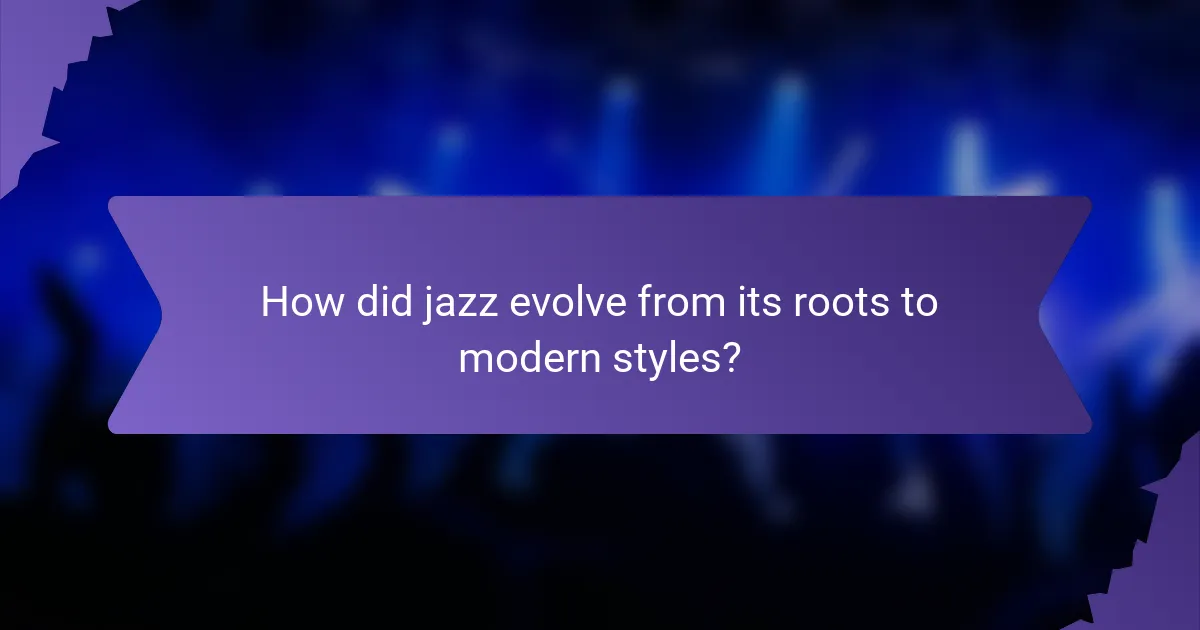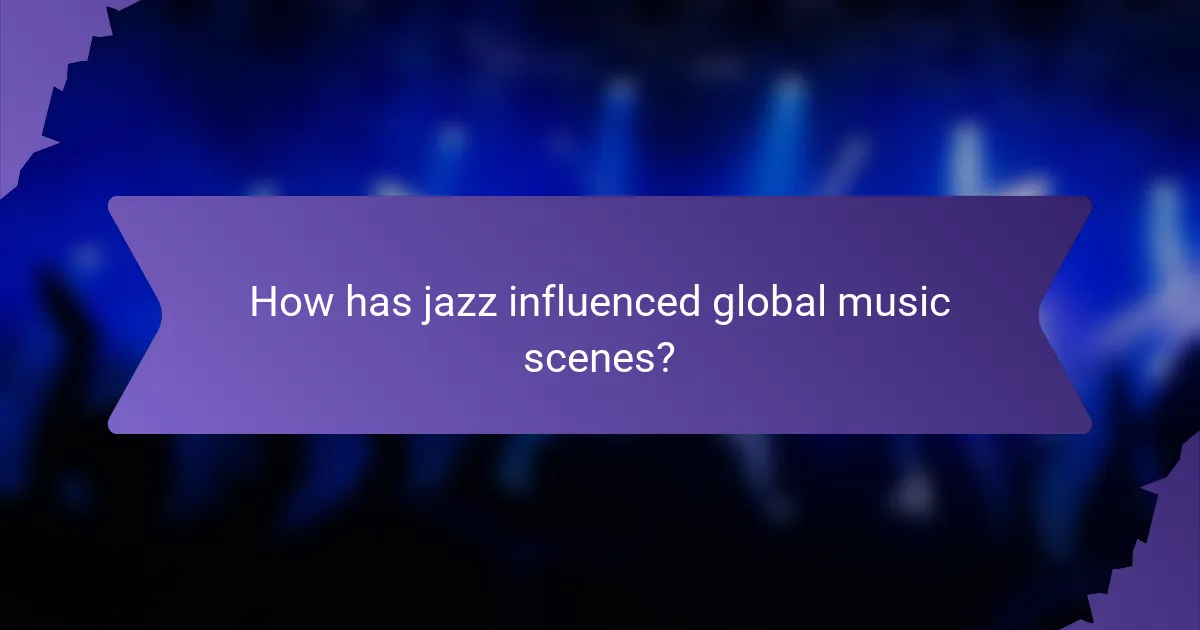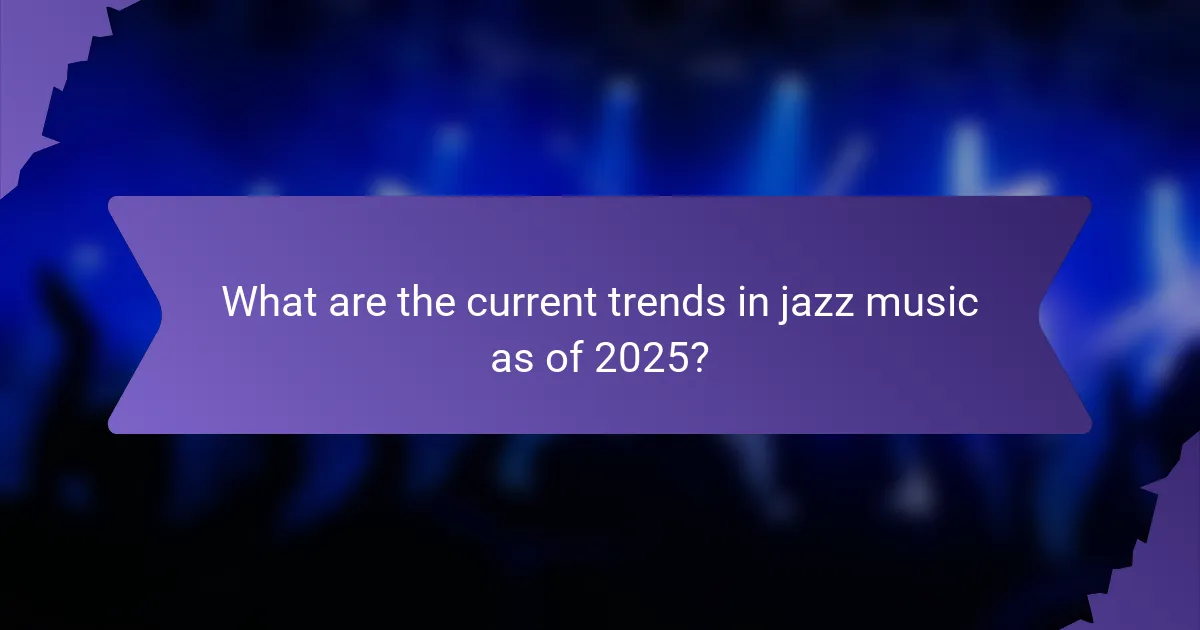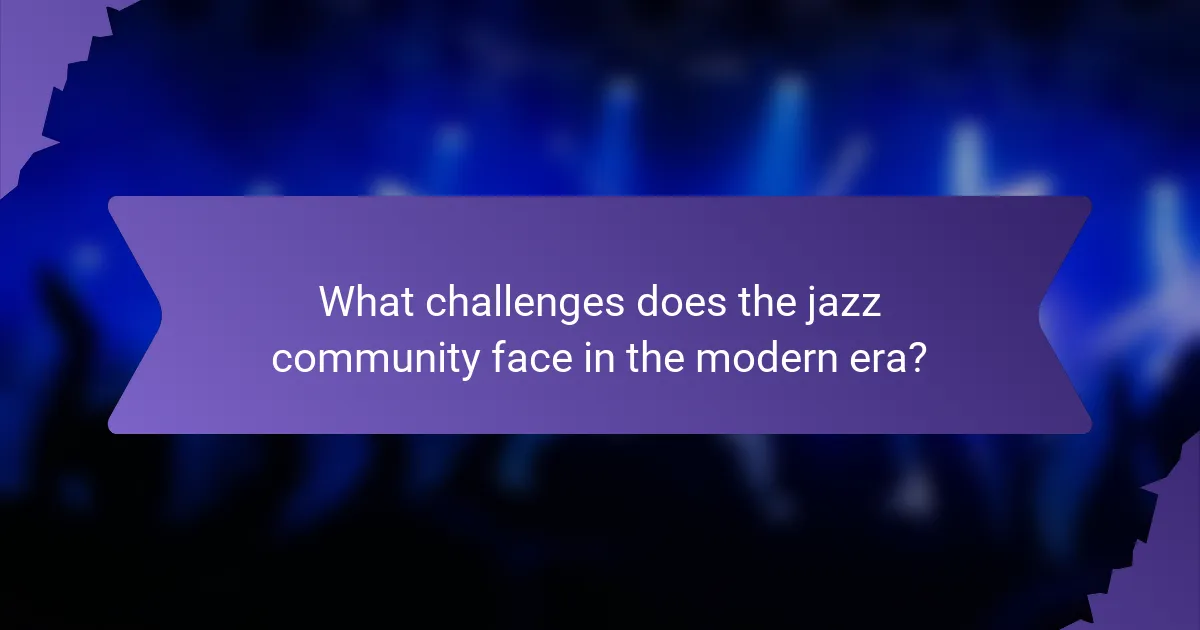Jazz continues to evolve, reflecting contemporary themes while honouring its rich heritage. This article explores the diverse styles that emerged from its roots, highlights iconic musicians who shaped the genre, and examines jazz’s global influence and current trends. Additionally, it addresses the challenges faced by the jazz community in maintaining relevance in today’s music landscape.

How did jazz evolve from its roots to modern styles?
Jazz evolved through a blend of African rhythms, European harmonies, and cultural influences, leading to diverse modern styles. The genre’s roots in African American communities in the early 20th century laid the foundation for innovations by iconic musicians like Louis Armstrong and Duke Ellington. As jazz spread globally, it absorbed elements from various cultures, resulting in unique subgenres such as bebop, fusion, and smooth jazz. Today, jazz continues to evolve, reflecting contemporary themes and technologies while honouring its rich heritage.
What are the key characteristics of early jazz forms?
Early jazz forms are characterised by improvisation, syncopation, and a strong rhythm section. Key styles include ragtime, New Orleans jazz, and swing. These styles emphasise collective improvisation, where musicians interact dynamically. Iconic musicians like Louis Armstrong and Duke Ellington shaped these styles, contributing distinctive sounds and innovations. The global reach of jazz further diversified its forms, blending with local musical traditions.
Which innovations shaped the development of jazz in the 20th century?
Innovations such as improvisation, swing rhythm, and electronic instruments significantly shaped jazz in the 20th century. The introduction of swing in the 1930s transformed jazz into a danceable genre, while musicians like Louis Armstrong and Duke Ellington pioneered improvisational techniques that defined the style. The emergence of bebop in the 1940s brought complex harmonies and fast tempos, showcasing virtuosity. Later, the use of electric instruments in the 1960s expanded jazz’s reach, incorporating elements from rock and funk. These innovations collectively influenced jazz’s evolution, making it a dynamic and diverse musical form.
How did cultural movements influence jazz styles?
Cultural movements significantly shaped jazz styles by introducing new influences and social narratives. The Harlem Renaissance, for example, fostered creativity and encouraged African American musicians to express their cultural identity.
The Civil Rights Movement infused jazz with themes of struggle and resilience, leading to the development of styles like free jazz. Musicians like John Coltrane and Ornette Coleman pushed boundaries, reflecting societal changes through improvisation and experimentation.
Global influences also transformed jazz, with elements from Latin, African, and Asian music contributing to diverse styles. This cross-cultural exchange expanded jazz’s reach, making it a global phenomenon.
In summary, cultural movements acted as catalysts, inspiring innovation and evolution in jazz styles, while iconic musicians played pivotal roles in this transformation.
![]()
Which iconic musicians have defined the jazz genre?
Iconic musicians who have defined the jazz genre include Louis Armstrong, Duke Ellington, Miles Davis, John Coltrane, and Ella Fitzgerald. Each of these artists contributed unique styles and innovations that shaped jazz’s evolution. Louis Armstrong is celebrated for his virtuosic trumpet playing and vocal style. Duke Ellington’s compositions and big band arrangements expanded jazz’s reach. Miles Davis revolutionised jazz with his modal approach and fusion experiments. John Coltrane’s improvisational techniques pushed the boundaries of jazz harmony. Ella Fitzgerald’s vocal prowess and scat singing set new standards for jazz vocals. These musicians exemplify the rich diversity and global influence of jazz.
What contributions did Louis Armstrong make to jazz?
Louis Armstrong significantly shaped jazz through innovative trumpet playing, vocal techniques, and improvisation. His unique style popularised scat singing and emphasised solo performances, influencing countless musicians. Armstrong’s charisma and stage presence helped bring jazz into mainstream culture, marking a pivotal moment in the genre’s evolution. His recordings, such as “What a Wonderful World,” remain iconic, showcasing his ability to blend emotion with technical skill.
How did Miles Davis revolutionise jazz music?
Miles Davis revolutionised jazz music by introducing innovative styles like modal jazz and jazz fusion. His work, particularly in albums such as “Kind of Blue,” emphasised improvisation and emotional expression. Davis’s unique approach to harmony and rhythm transformed jazz into a more complex and diverse genre. His influence extended globally, inspiring countless musicians across various musical landscapes.
What role did Ella Fitzgerald play in the evolution of jazz?
Ella Fitzgerald significantly influenced jazz evolution through her exceptional vocal techniques and improvisational skills. Her ability to blend scat singing with traditional jazz forms helped expand the genre’s boundaries. Fitzgerald’s collaborations with prominent musicians like Duke Ellington and Louis Armstrong introduced innovative styles, elevating jazz’s prominence globally. Her unique attribute, a flawless pitch and rich tone, set her apart from contemporaries, making her a pivotal figure in jazz history. As a result, she inspired future generations of artists, solidifying her legacy in the evolution of jazz.

What are the distinct styles of jazz music?
Jazz music features distinct styles including traditional jazz, bebop, cool jazz, and fusion. Each style reflects a unique evolution and cultural influence within the genre. Traditional jazz, rooted in New Orleans, emphasises collective improvisation. Bebop emerged in the 1940s, showcasing complex harmonies and fast tempos. Cool jazz introduced a more relaxed, smooth sound in the 1950s. Fusion blends jazz with rock and funk, expanding the genre’s reach globally. Iconic musicians like Louis Armstrong, Charlie Parker, Miles Davis, and Herbie Hancock have significantly shaped these styles, contributing to jazz’s rich legacy.
How does bebop differ from traditional jazz?
Bebop differs from traditional jazz by emphasising complex harmonies, fast tempos, and improvisation. Traditional jazz focuses on melody and rhythm, often featuring structured arrangements.
Bebop musicians like Charlie Parker and Dizzy Gillespie introduced intricate chord progressions and rapid improvisational techniques. This shift marked a move towards a more artistically expressive form of jazz, prioritising individual creativity over danceability.
While traditional jazz often includes a steady beat suitable for dancing, bebop is more cerebral and suited for attentive listening. The unique attributes of bebop highlight its role in jazz evolution, influencing various genres and inspiring musicians worldwide.
What defines smooth jazz as a genre?
Smooth jazz is defined by its relaxed tempo, melodic improvisation, and incorporation of elements from various genres. It emerged in the late 1960s, blending traditional jazz with pop and R&B influences. Notable musicians like Grover Washington Jr. and David Sanborn helped popularise the style. Its unique attribute lies in the smooth, polished sound that creates an easy listening experience. Smooth jazz often features electronic instruments and sophisticated arrangements, appealing to a broad audience globally.
How has jazz fusion expanded the genre’s boundaries?
Jazz fusion has significantly expanded the genre’s boundaries by blending elements from rock, funk, and world music. This genre emerged in the late 1960s, characterised by its innovative use of electric instruments and complex rhythms. Iconic musicians like Miles Davis and Herbie Hancock pioneered this style, incorporating diverse influences that challenged traditional jazz norms. As a result, jazz fusion has fostered global collaborations, leading to new sub-genres and a broader audience, thus redefining what jazz can encompass.

How has jazz influenced global music scenes?
Jazz has profoundly influenced global music scenes by introducing diverse styles and fostering cross-cultural collaborations. Its improvisational nature allows for unique expressions, impacting genres like rock, hip-hop, and world music. Iconic musicians, such as Louis Armstrong and Miles Davis, have shaped these transformations, showcasing jazz’s adaptability. As a result, jazz remains a vital force in contemporary music, inspiring artists worldwide to blend its elements into their creations.
Which countries have developed their unique jazz styles?
Countries that have developed unique jazz styles include the United States, Brazil, France, and South Africa. Each nation has infused its cultural elements into jazz, creating distinctive sounds.
The United States is the birthplace of jazz, showcasing styles like New Orleans jazz and bebop. Brazil’s bossa nova blends samba rhythms with jazz harmonies. France has cultivated a vibrant gypsy jazz scene, while South Africa’s township jazz reflects its rich cultural heritage.
These styles highlight the global influence and adaptability of jazz, demonstrating its ability to evolve and incorporate diverse musical traditions.
What impact has jazz had on contemporary genres worldwide?
Jazz has significantly influenced contemporary genres worldwide, shaping styles like rock, hip-hop, and electronic music. Its improvisational techniques and complex harmonies have been integrated into various musical forms, fostering innovation. Iconic musicians such as Miles Davis and John Coltrane have inspired countless artists, pushing boundaries across genres. As a result, jazz remains a foundational element in the global music landscape, promoting cross-cultural collaborations and new creative expressions.

What are the current trends in jazz music as of 2025?
Current trends in jazz music as of 2025 include a fusion of genres, increased use of technology, and a focus on social issues. Jazz musicians are blending styles like hip-hop and electronic music, creating innovative sounds. Iconic musicians, such as Kamasi Washington and Esperanza Spalding, are leading this evolution. Global reach has expanded through digital platforms, allowing diverse influences and collaborations. This trend reflects a unique attribute of jazz: its adaptability and continuous evolution.
How are technology and social media shaping modern jazz?
Technology and social media are significantly transforming modern jazz by enhancing collaboration and expanding its audience. Digital platforms allow musicians to share their work globally, fostering innovative styles and diverse influences. Streaming services have democratized access to jazz, enabling artists to reach listeners without traditional gatekeepers. Social media facilitates real-time interaction between musicians and fans, creating a vibrant community. As a result, modern jazz reflects a fusion of traditional elements and contemporary trends, showcasing unique attributes and global cultural exchanges.
Which emerging artists are pushing the boundaries of jazz today?
Emerging artists like Kamasi Washington, Esperanza Spalding, and Christian Scott aTunde Adjuah are redefining jazz today. They blend traditional elements with modern influences, pushing genre boundaries. Kamasi Washington’s album “The Epic” showcases orchestral jazz, while Esperanza Spalding incorporates elements of funk and R&B. Christian Scott aTunde Adjuah’s “Stretch Music” merges jazz with hip-hop, emphasizing improvisation and cultural narratives. These artists reflect the genre’s evolution and global reach, attracting diverse audiences.

What challenges does the jazz community face in the modern era?
The jazz community faces significant challenges in maintaining relevance and support in the modern era. Key issues include declining live performance attendance, competition from digital music platforms, and limited funding for jazz education.
Additionally, preserving the genre’s rich history while fostering innovation poses a unique challenge. Many iconic musicians struggle to gain recognition in a crowded music landscape, impacting their ability to reach new audiences. As a result, the jazz community must adapt to changing cultural dynamics while staying true to its roots.
How is the preservation of jazz heritage being addressed?
The preservation of jazz heritage is being addressed through education, documentation, and community engagement. Educational programs in schools and community centres aim to teach jazz history and techniques. Documentation efforts include archiving recordings and written materials to ensure accessibility. Community engagement fosters local jazz scenes, encouraging performances and collaborations that celebrate this musical tradition. These combined efforts help maintain jazz’s cultural significance and promote its evolution globally.
What role do jazz festivals play in promoting the genre?
Jazz festivals play a crucial role in promoting the genre by showcasing diverse styles and connecting audiences with iconic musicians. These events foster community engagement and cultural exchange, enhancing jazz’s global reach. Festivals often feature performances, workshops, and discussions, enriching the audience’s understanding of jazz’s evolution. By highlighting both established artists and emerging talent, festivals ensure the genre’s continued relevance and growth.
How can listeners support the jazz community effectively?
Listeners can support the jazz community by attending live performances, purchasing music, and promoting local artists. Engaging with jazz through social media can also raise awareness and connect fans. Supporting educational programs ensures future generations learn jazz’s rich history. Collaborating with local venues fosters a vibrant scene, enhancing the overall experience for both artists and audiences.
What are best practices for discovering and enjoying jazz music?
To discover and enjoy jazz music, immerse yourself in its diverse styles, explore iconic musicians, and appreciate its global influence. Start by listening to classic albums, attending live performances, and engaging with online communities.
Explore various jazz styles such as bebop, smooth jazz, and free jazz to understand the genre’s evolution. Iconic musicians like Louis Armstrong, Duke Ellington, and Miles Davis shaped jazz, each contributing unique attributes. For instance, Armstrong’s improvisational skills and Davis’s innovative approaches are pivotal in jazz history.
Attend local jazz festivals or clubs to experience live performances. These events often feature a mix of established and emerging artists, showcasing the genre’s vibrant culture. Engaging with fellow jazz enthusiasts can enhance your appreciation and understanding.
Utilise streaming platforms to create personalised playlists that highlight different jazz styles and eras. This allows for a tailored listening experience, helping you discover new artists and tracks that resonate with your preferences.